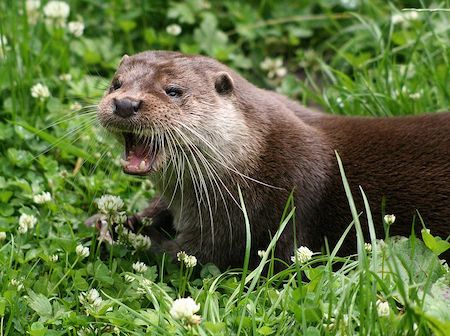Eurasian otter found in kerala
A team of researchers recently discovered a Eurasian otter in the Chinnar Wildlife Sanctuary in Idukki, a first in Kerala.
source: Internet
The Eurasian otter (Lutra lutra), also known as the European otter, Eurasian river otter, European river otter, common otter, and Old World otter, is a semiaquatic mammal native to Eurasia and Maghreb. The most widely distributed member of the otter subfamily (Lutrinae) of the weasel family (Mustelidae),
It is found in the waterways and coasts of Europe, many parts of Asia, and parts of northern Africa. The Eurasian otter has a diet mainly of fish, and is strongly territorial. It is endangered in some parts of its range, but is recovering in others.
Eurasian otters are brown above and cream below, and have short limbs, webbed feet, and claws. They have two layers of fur, a thick waterproof outer layer and a warm inner layer. They also have dense, short fur that traps a layer of air to insulate them.
source: Internet
About Eurasian Otter:
- It is a semi-aquatic carnivorous mammal native to Eurasia.
- Scientific Name: Lutra lutra
Distribution of Eurasian Otter:
-
- It has one of the widest distributions of all Palearctic mammals, from Ireland to China and down to Southeast Asia.
- It lives throughout Europe, North Africa, and Asia.
- In India, it occurs in northern, northeastern, and southern India.
Habitat of Eurasian Otter:
-
- It inhabits streams, rivers, lakes, freshwater and peat swamp forests, ocean shores, rice fields, fjords, caves, and other terrestrial habitats close by waterways.
- In the Indian subcontinent, it is found in cold hills and mountain streams.
Conservation Status of Eurasian Otter:
-
- IUCN: Near threatened
- Wildlife Protection Act, 1972: Schedule II
- CITES: Appendix I
Key Facts about Chinnar Wildlife Sanctuary (CWS):
- Location:
- It is located in Idukki District, Kerala.
- It lies in the rain shadow region of the Western Ghats and receives very less rainfall every year.
- The south side of the sanctuary is covered by Eravikulam National park, and the north side is by Indira Gandhi Wildlife Sanctuary.
- Vegetation:
- It has a wide array of habitat types, like deciduous forests, dry thorn scrub, riparian forest, shoals, and grasslands.
- There is an extensive sandalwood forest nearby the sanctuary.
- Flora:
- Chinnar has about 1000 species of flowering plants and a wide variety of medicinal plants.
- The major species of flora include Acacia arabica, Acacia leucofolia, Acacia concinna, antallum album, Anogeissus latifolia, Rhododendron nilagiricum, Elaeocarpus, etc.
- Fauna:
- It is home to the endangered Great Grizzled Squirrel of India.
- Other important mammals that you can see here are the elephant, tiger, leopard, guar, sambar, spotted deer, Nilgiri Tahr, etc.
